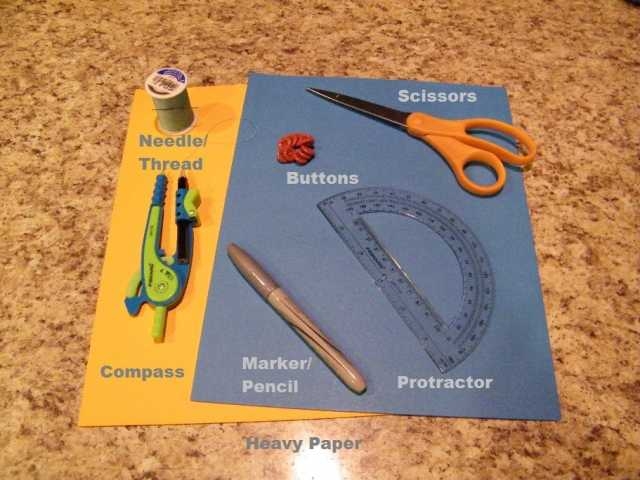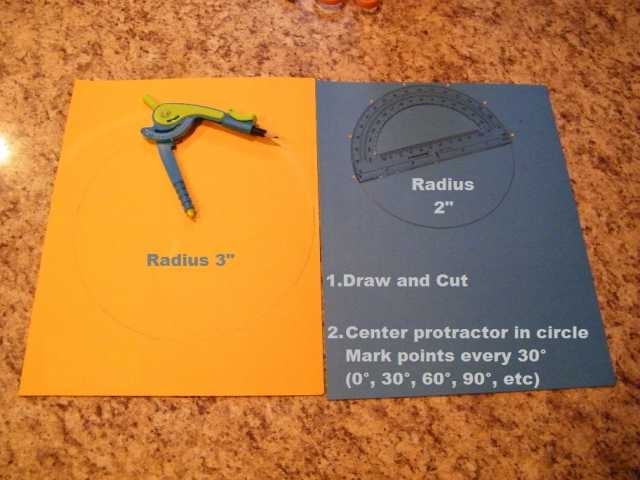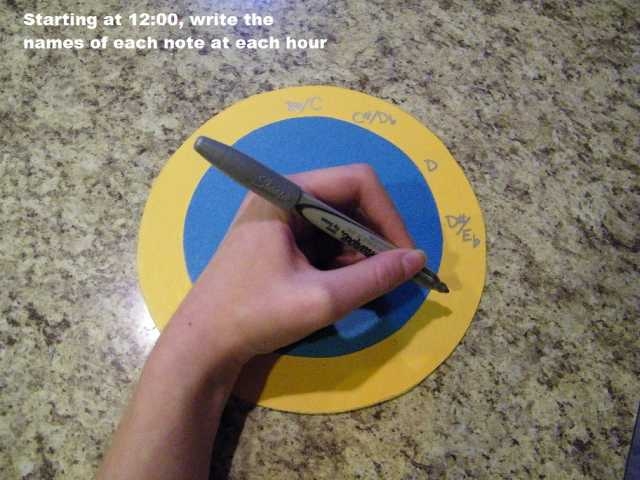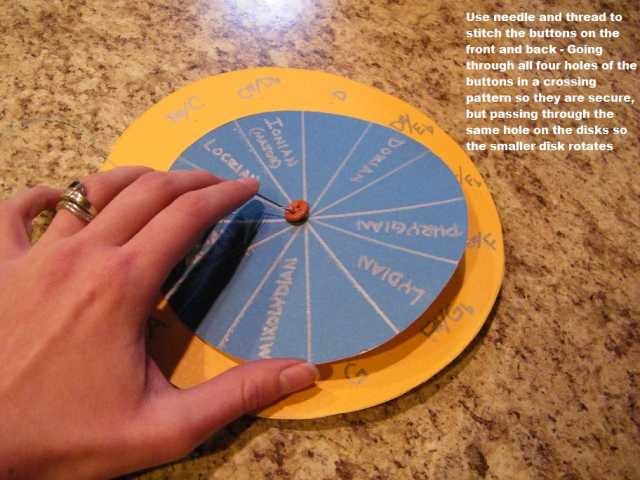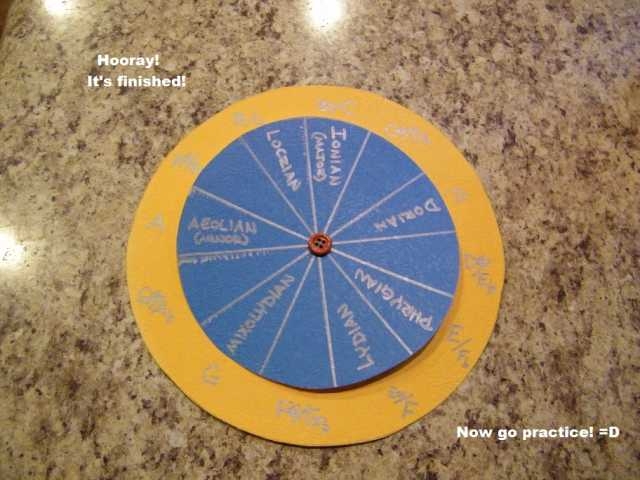Welcome to our forum. A Message To Our New and Prospective Members . Check out our Forum Rules. Lets keep this forum an enjoyable place to visit.
Currently working on errors from the latest (SimplePress) forum update. Many issues have been resoled and others are being worked on. Thank you for your patience.
 Topic RSS
Topic RSS



 (2 votes)
(2 votes) Regulars
 Offline
Offline
I have designed a low-tech computer for finding the scale for any key signature and any mode. I spent some time searching the web for something similar but did not find anything.
A given key signature has scales in seven modes. There are twelve different key signatures. The 84 resulting scales are called the diatonic scales.
Here I describe how to make the computer. AndieKae has followed the directions (and helped me write them). She promises to post pictures of the steps in making hers.
============================================
Tools:
* compass(for drawing circles)
* scissors
* protractor
* pencil and pen
* marker
* small nail
* sewing needle
The compass and protractor make things easier, but there are ways of doing without them.
Materials:
* stiff paper material (something like manila folders or a cereal box or even corrugated cardboard, preferably two different colors)
* two clothing buttons (say 1/4" to 3/4", the smaller the better, the kind with two or four holes)
* thread
Procedure:
1) From the stiff paper, make a disk of radius 3" and a disk of radius 2". That way your computer will be 6" in diameter, but you can make it any size you like. Preferably, use a different color for each disk. Draw circles using the compass, and cut out the disks using the scissors.
2) Mark the twelve clock points lightly in pencil on the perimeters of each disk. You can use the protractor for that, placing a clock point every 30 degrees.
3) On the larger disk, at each of the twelve clock points, write the names of a pitch of the chromatic scale, so that going clockwise around the disk represents an ascent of the chromatic scale. The names must be placed so that they will not be covered up by the small disk when the disks are placed concentrically. When using the computer, the larger disk will be held stationary, while the smaller disk will be rotated. Therefore all the note names should be oriented the same way, so that they are all readable right-side-up at the same time, like the numbers on a clock face.
Some of the twelve pitches commonly go by more than one name. Use the following names starting at twelve o'clock and moving clockwise: C, C#/Db, D, D#/Eb, E, E#/F, F#/Gb, G, G#/Ab, A, A#/Bb, B/Cb. If you like, you can put some other note, say A, at 12:00 instead of C. Notice that some of the pitches have rarely-used aliases,for example Cb as an alias for B. You might want to write those aliases (namely E# and Cb) smaller so that they are less prominent.
4) On the perimeter of the smaller disk, use the marker to make prominent marks at 12, 2, 4, 5, 7, 9, and 11 O'clock positions. Write the names of the modes at the hour positions as follows:
12: Ionian(Major)
2: Dorian
4: Phrygian
5: Lydian
7: Mixolydian
9: Aeolian(minor)
11: Locrian
5) Use the nail to make small holes in the centers of the disks. Sew the buttons and the two disks together so that going from top to bottom there is 1) a button, 2) the smaller disk, 3) the larger disk, 4) a button. The strands of thread should all pass neatly through the two holes in the disks so that the upper disk can be rotate easily.
Regulars


Regulars
 Offline
Offline


This is really cool. Nice bit of work and thinking.
However...... I did note that the granite working table "seems" to have changed color. The card stock seems the same. The buttons and the drawn lines- no change. The marker, string compass and protractor....same,same,same...and..of course same. The shadows seem off for some reason. Almost like multiple light sources were being used.
This only draws me to 1 conclusion. You did not make this on the moon. I wager, you didn't even go to the moon. I don't even think Bigfoot was involved when you made this and the funds from DB Cooper didn't pay for any of it. It makes one, kind of ask further questions about all this and you're motivations. To me, IMHO, it appears to have been all fabricated in a kitchen, study or possibly, even on a craft table.


"I find your lack of Fiddle, disturbing" - Darth Vader
Regulars

This is a great thread and will be a ton of help! Thanks for all the work you put into this. I suppose I know what my next craft project will be... ![]()
"I know a girl who cries when she practices violin because each note sounds so pure it just cuts into her, and then the melody comes pouring out her eyes. Now, to me, everything else just sounds like a lie."
Regulars



Members
 Offline
Offline





Excellent bit of work, and a nicely designed little tool!
![]()
"This young wine may have a lot of tannins now, but in 5 or 10 years it is going to be spectacular, despite the fact that right now it tastes like crude oil. You know this is how it is supposed to taste at this stage of development." ~ Itzhak Perlman
Regulars
 Offline
Offline
Ferret said
Great mateSort out any buggs and make it look good and sell it on eBay. I mean it
Thank you.
Had AndieKae not suggested that she do the pictures, probably the thread wouldn't have gotten much notice. Maybe folks wouldn't have believed that anyone had actually built one. I couldn't have expected that she would do them so well, or with the text she inserted. So she deserves some big thank yous.
Advanced member
 Offline
OfflineHow can it be that no one has marketed something like this??? If I had the gumption and the $$$ I'd steal this and be rich. No, really, I'd credit you and this forum. Might share the riches too.
But seriously, somebody make this in a drawing program that can be cut out and put together with one of those wire brad thingies that I haven't seen around for ages. Fiddlerman -- you could offer this as a free .pdf download. If I wasn't lying in bed feeling sorry for myself with a sinus infection I'd start working on a printable .pdf for you. Maybe I will anyway.
I have not learned the modes except in a music theory class. It took me a few minutes to understand how to use the wheel -- just put the mode over the key you want it in, and the blank spaces are notes you do not play, right? Someone can surely explain that more elegantly.
Fiddlrgrrl
Regulars
 Offline
Offline
@Ferret @FiddleDetroit @FinalPatriot @DanielB @fiddlrgrrl and everyone: thank you for your generous remarks. I hope this can help people understand the diatonic system of keys and modes and scales and its relation to the chromatic scale. Of course 'diatonic' is a fancy way of referring to the common system we use all the time.
I am attaching a close-up photo of one of the computers I've made. It is conceptually no different from the one @AndieKae made, and is consistent with the instructions above. I have also started a separate thread with details of using it: https://fiddlerman.com/forum/s.....es-part-2/
@Fiddlerman and everyone: If you have questions or objections after looking at the device up close, please let me know. I am happy to explain it.
Advanced member
 Offline
OfflineGood pic. Thanks!
Pierre, I don't understand your earlier comment that there are not enough blank spaces. Playing the spaces that are NOT blank produces the right scale, I think. Or am I doing it wrong?
BTW, rereading my own earlier comment about "surely someone can explain this more elegantly" I meant more elegantly than I had just written. I hope it didn't look like I was sarcastically criticizing the work you've done.
Fiddlrgrrl


 Log In
Log In Register
Register





